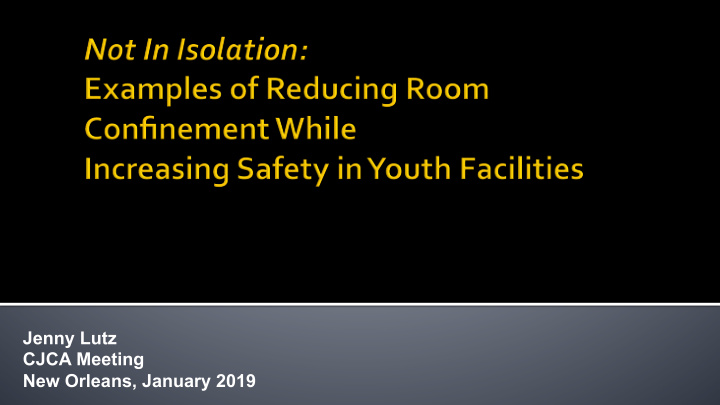



Jenny Lutz CJCA Meeting New Orleans, January 2019
Who We Work With • Facilities and state agencies • Court systems • Legislators and legislative committees • Professional organizations • Advocates and attorneys • Youth and family members 2
Five Strategies to Reduce Isolation 1. Adopt mission statement and philosophy that reflects rehabilitative goals; 2. Develop policies and procedures for use and monitoring of isolation; 3. Identify data to manage, monitor, and be accountable for the use of isolation; 4. Develop alternative behavior management options and responses; and 5. Train and develop staff in agency mission, values, standards, goals, policies, and procedures. http://cjca.net/wp-content/uploads/2018/02/CJCA-Toolkit-Reducing-the-Use-of-Isolation-1.pdf 3
Tells the stories of state and county facilities and how they put CJCA strategies into practice. ① Understanding the concerns and needs of staff ② Isolation is connected many other areas of facility operations and culture ③ Concrete examples help from credible messengers 4
¡ Profiles 4 facilities ¡ Interviewed administrators and staff ¡ Concrete examples ¡ Sample policies, individual plans, staff training materials, and data reports. Available Spring 2019 www.stopsolitaryforkids.org/not-in-isolation/ 5
Isolation Flowchart “Accountability isn’t put a kid in a room, and accountability isn’t punishment. Accountability is Skill Development learning to own their behavior by trying to make Coordinators it right and learning skills to try not to do it again. That’s accountability.” Stop Think Explore Plan – Facility Supervisor CARE Teams Ohio Dept. of Youth Services saw acts of violence go down 22% in one year Incidents of isolation went from 370 to while isolation was reduced 89%. 140 when OYA limited isolation to minimum time for crisis behavior. 6
State Laws: California, Colorado, Connecticut, Nebraska, New Jersey, Oregon, D.C., Seattle DEC. 2018 Federal Laws States Must: • Not as punishment or discipline • Report annually on isolation • Describe policies, procedures, + • Serious and immediate risk of alternative behavior techniques used to physical harm reduce isolation • Train to improve conditions like isolation • Max 3 hours • No youth in adult jails except narrow circumstances 7
Recommend
More recommend